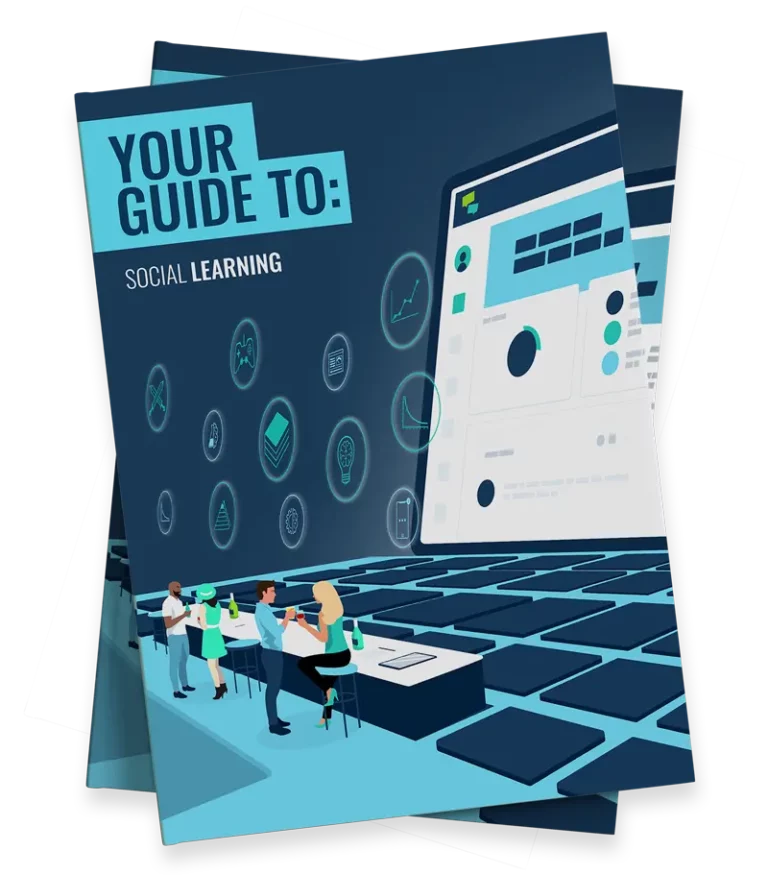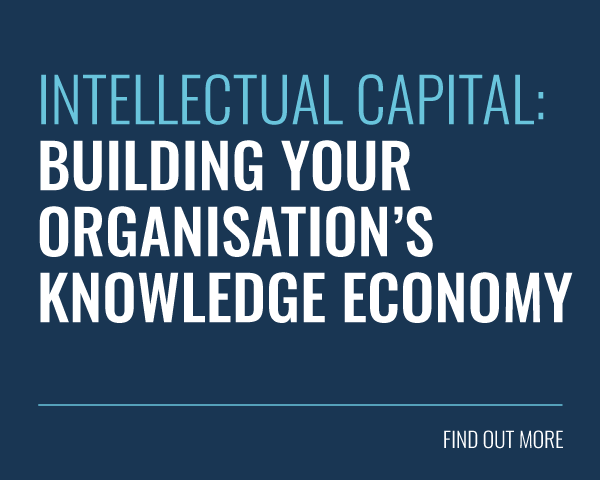
Social learning is no longer a trend; it’s a necessity. Organisations across industries are recognising the transformative power of harnessing collective intelligence to drive performance and innovation.
In fact, over half of L&D professionals are already leveraging social learning to enhance their structured workplace training programmes.
This approach works because people are social beings that long for connection. As a result, social learning has the ability to strengthen learning communities, create a thriving knowledge economy, and ultimately drive business productivity.
Social learning has even been shown to deliver a staggering 75:1 return on investment compared to traditional web-based training. Not bad, right?
This article will unpack the four key principles of social learning, the core benefits of this approach, and provide actionable tips for successful implementation. Ready to embark on this next learning journey together? Then join us around the firepit and let’s get started!
What is Social Learning?
Let’s start with a formal definition of this informal type of learning (oh the irony!).
Social Learning is the active process of learning from our observations and interactions with others.
Simple, right? To get a better understanding of how this works, let’s break this down further.
Learning is the process of acquiring new information through self-study, experience or through formal instruction. In the case of social learning, learning takes place within a social context. It happens through our observations and interactions with friends, family, colleagues or even strangers.
And that is where the formality ends. In fact, social learning is the most informal type of learning. And because it takes place in a social context, we never get tired of it. In fact, it has been happening for as long as people have been around, even before any formal instruction took place.
For thousands of years, we’ve used social learning to create, to build and most importantly, to teach. Without it, we’d still be in the Stone Age, scratching our heads and wondering when the future was arriving.
Social Learning in the Workplace
Today, organisations across the world have taken inspiration from our natural human urge to interact. Social learning is no longer just an academic concept. It’s a business essential.
Within the workplace, social learning can transpire in a variety of contexts. For example:
- Shadowing or observing experienced employees to learn job tasks and processes.
- Casual conversations between colleagues that lead to valuable insights and problem-solving.
- Employees collaborating on projects, sharing expertise and best practices.
- Learning from experienced colleagues through one-on-one interactions with coaches and mentors.
- Collaborating through social platforms like Slack, Teams or Yammer.
More learning happens socially than you might expect. The 70:20:10 model vividly illustrates this, by showcasing the different means by which we acquire knowledge. It tells us:
- 70% of learning happens through experience.
- 20% comes from interactions with colleagues and friends.
- 10% is derived from formal training and education.
This model underscores the critical role of social learning and experience in developing skills and knowledge. But let’s take a step back to explore the roots and foundations of social learning.
The History of Social Learning
The 1920s: Lev Vygotsky’s Socio-Cognitive Learning Theory
Lev Vygotsky, a pioneering Russian psychologist, laid the groundwork for much of our understanding of social learning. His groundbreaking theory suggests that learning is fundamentally a social process, where knowledge and skills are co-constructed through interaction with others.
He proposed that learning flourishes when individuals operate within their Zone of Proximal Development (ZPD). This is the sweet spot between what learners can accomplish independently and what they can achieve with guidance from a ‘more knowledgeable other’.
Essentially, Vygotsky provided a theoretical foundation for understanding how social interactions can accelerate learning and development. Sadly, his theories didn’t catch on during his lifetime. Thankfully, they continue to be discovered and studied to this very day. Thank you Lev!
The 1960s: Albert Bandura’s Social Learning Theory

Our modern understanding of social learning owes a significant debt to Albert Bandura. A Canadian-American psychologist, Bandura’s Social Learning Theory, developed in the 1960s, revolutionised our perception of how learning occurs.
The theory was Bandura’s response to the popular behaviourist models of the time. These theories suggested that learning is solely a product of direct experience and conditioning. Bandura proposed a more comprehensive view.
He argued that people learn through a combination of observing others, processing information cognitively, and then reproducing observed behaviours. This is exemplified by Bandura’s iconic Bobo doll experiments.
1961: The Bobo Doll Experiment
Bandura’s famous Bobo doll experiments were designed to test his social learning theory. In these experiments, children observed adults interacting with a large inflatable doll called Bobo. The process can be broken down into three stages:
- Observation: Children watched as adults either behaved aggressively towards the doll (hitting it, for instance) or played with it gently.
- Imitation: After observing the adult, the children were placed in a room with various toys, including a Bobo doll.
- Behaviour: Researchers then observed the children’s behaviour to see if they imitated the aggressive or non-aggressive actions that they had witnessed.
As you might have guessed, children who had observed aggressive behaviour were more likely to exhibit aggressive behaviour towards the doll. This demonstrates that children learn behaviours by observing and imitating others.
Three Core Concepts of Bandura’s Social Learning Theory
Let’s explore Bandura’s theory in more detail. Here are the three key concepts you need to know:
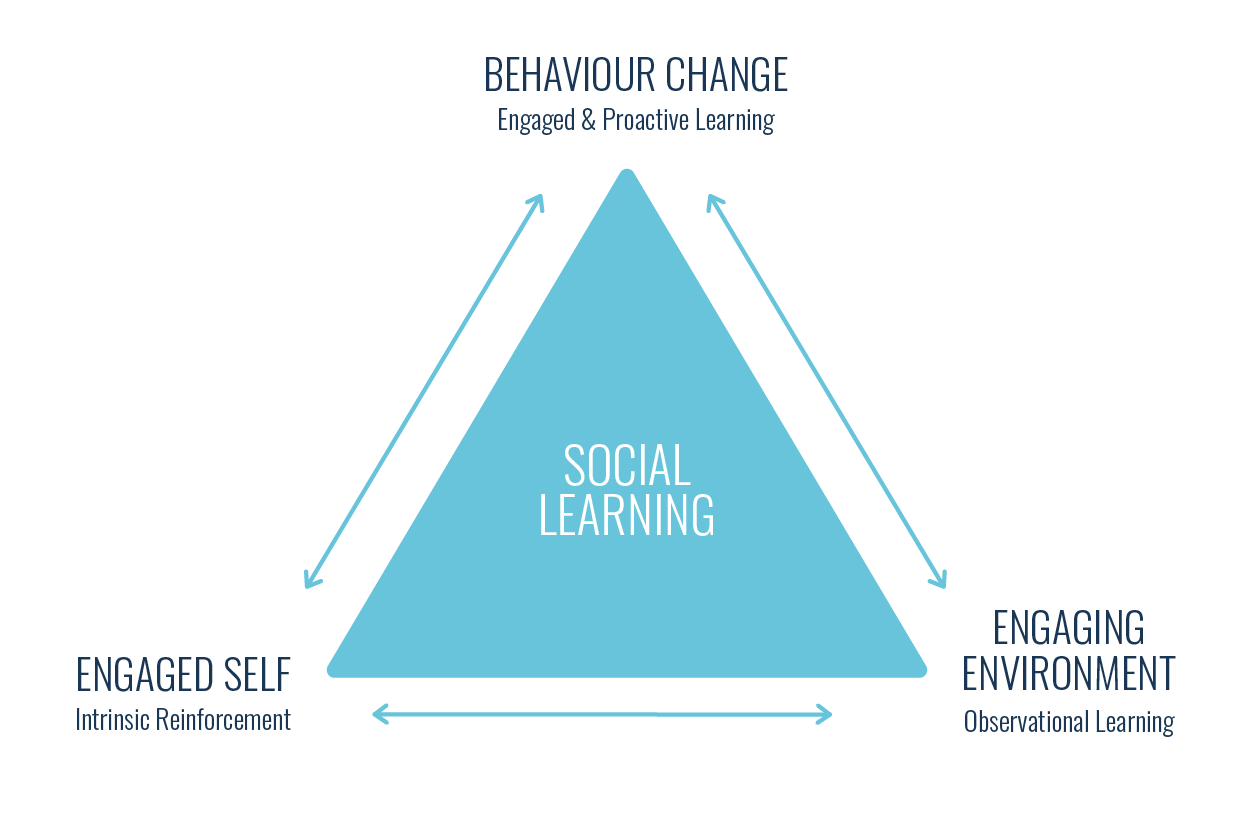
1. Observational Learning
The theory of social learning tells us that you do not need direct experience in order to learn. In fact, scientists have found that the limbic brain lights up simply by observing others. This is the region of the brain responsible for forming associations between actions and outcomes.
As such, one can learn simply by observing. This principle underpins our ability to learn vicariously by modelling the behaviours of others.
2. Intrinsic Reinforcement
Social learning works because it taps into our deepest motivations. Satisfaction, pride, and a sense of accomplishment drive individuals to engage in social learning activities. The desire to learn and grow is often self-motivated.
One example of this is our inherent desire for a sense of purpose or ‘Epic Meaning’. As such, we are not merely puppets of classical conditioning. Instead, we are empowered and independent agents of action. We’ll toast to that!
In fact, a McKinsey study shows that employees who are intrinsically motivated are 46% more satisfied and committed in their jobs. In the context of training, highly motivated employees have also been shown to be 6.6% more productive.
3. Behaviour Change
Behaviour change is the ultimate outcome of effective social learning. By observing and imitating others, we acquire new behaviours, skills, and attitudes. Social learning helps us to understand how these behaviours are formed and then integrated into everyday life.
Social learning theory highlights the complexity of behaviour change. BJ Fogg’s Behaviour Model offers a valuable framework for understanding this process. It suggests that behaviour (B) is a function of three key elements: motivation (M), ability (A), and a trigger (T), encapsulated in the formula B=MAT.
- Motivation: humans’ extrinsic or intrinsic desires which drive us to act.
- Ability: the capability to actually carry out our desired actions.
- Trigger: the mechanisms or levers to set off an action or behaviour.
Bandura’s Four Principles of Social Learning
We’ve finally arrived at the section you’ve been waiting for. We’re going to look at how social learning can be used to drive genuine behaviour change. After all, that’s the secret to driving real business impact from your training initiatives.
Bandura identified four key processes involved in observational learning.
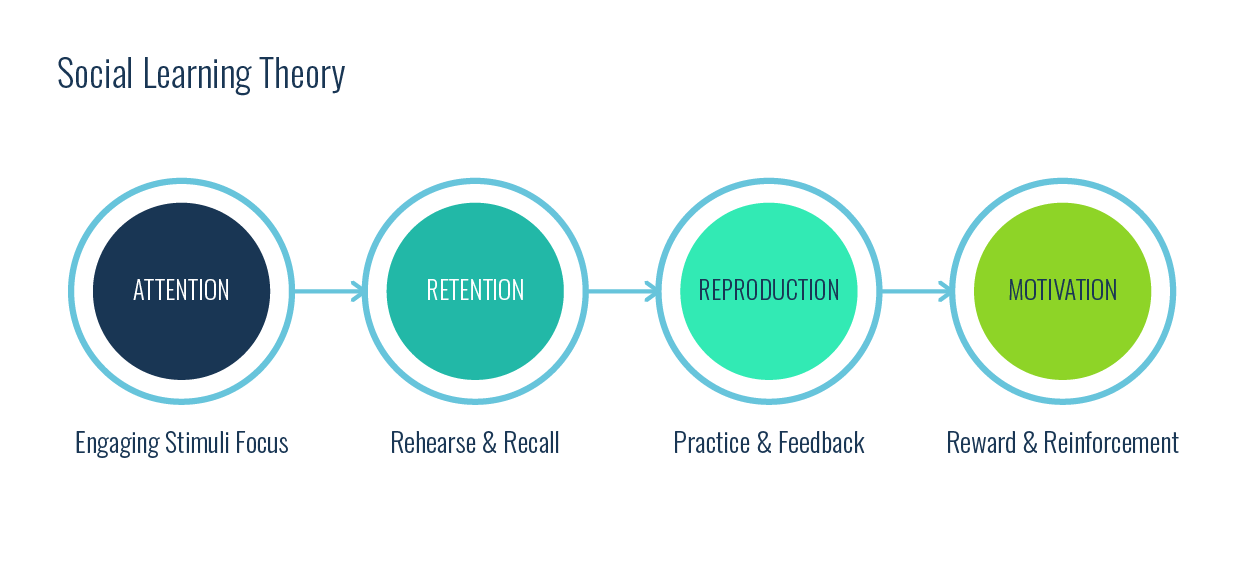
- Attention: Learning cannot take place if your audience is not engaged. As such, for us to observe something, it needs to capture our focus in some way. For example, neuroscience shows us that things that are novel or relevant are more likely to seize your learners’ undivided attention.
- Retention: Once you’ve captured your audience’s attention, you then need to ensure that they remember what they’ve seen and retain the information. This involves cognitive processes like encoding, storage, and retrieval.
- Reproduction: This is social learning in action. At this stage, passive learning is freed from its cognitive cage and enacted in the real world. Your learners’ first attempts will typically involve them modelling the behaviour based on the memory retained from the first two steps.
- Motivation: Ah, the holy grail to long-term engagement and behaviour change. Motivation is the key ingredient to reinforce and sustain social learning in the workplace. This is where the right rewards or reinforcements are introduced to help keep those social fires burning.
These four steps will help you deliver the right social learning strategies for your workplace. In turn, this is what will drive real and lasting behaviour change.
The Benefits of Social Learning
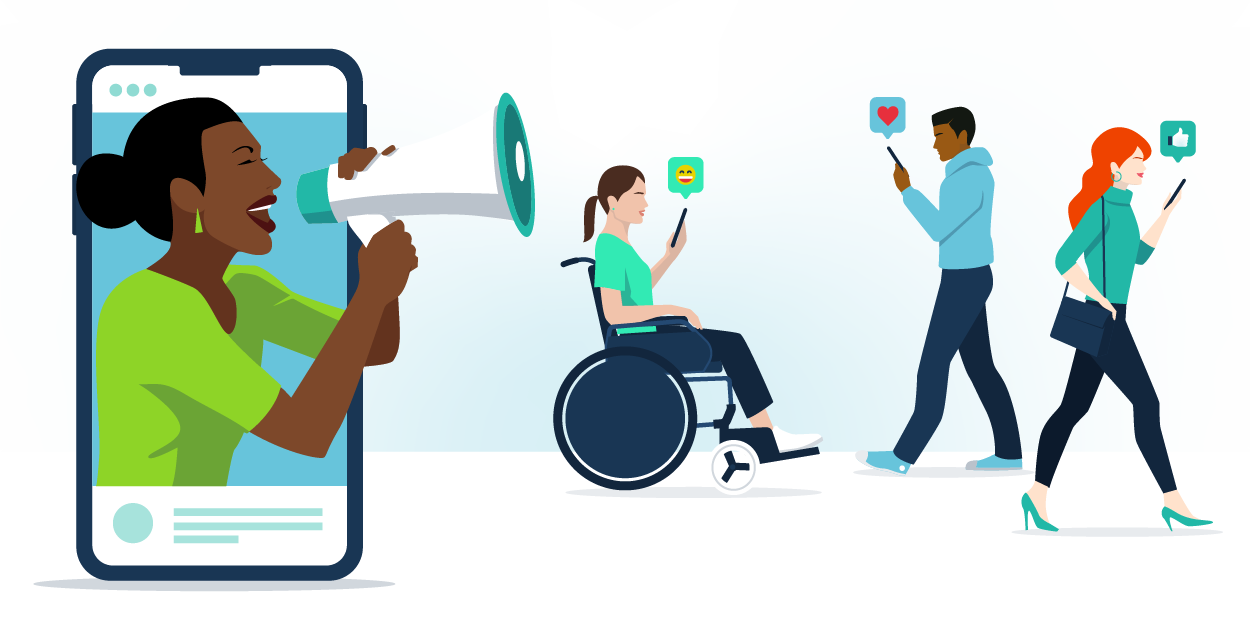
There’s a reason why 5.07 billion people around the world now use social media. We’re social animals who crave interaction with our peers.
When we get that interaction, we become more engaged. As a result, we are more likely to repeat those actions again in the future and form new habits.
In fact, social learning offers a myriad of advantages for individuals and organisations. Let’s explore some key benefits:
- Knowledge Retention: Learning through social interaction solidies knowledge by adding real-world context and other useful insights.
- Increased Engagement: As we’ve seen, social learning taps into intrinsic motivation, which in turn has a positive impact on learner engagement.
- Improved Skills: Collaborative problem-solving fosters creative solutions to challenges and helps to foster a culture of innovation.
- Boosted Confidence: Sharing knowledge and receiving positive feedback enhances your learners’ self-esteem and confidence.
- Quicker Results: Social learning can also accelerate the spread of critical information. This can improve your learners’ time to competence.
By harnessing the power of social learning, organisations can create a more dynamic, engaged, and high-performing workforce. In fact, social learning is your primary means for protecting your company’s intellectual capital.
But don’t just take our word for it. Let’s take a look at what the research has to say.
Research into Social Learning
While the anecdotal evidence for the effectiveness of social learning is compelling, you’ll also be glad to hear that rigorous research has also contributed to our understanding of this powerful learning approach. Here are some of the key findings from social learning research:
- McKinsey research indicates that organisations can boost productivity by up to 35% by leveraging social learning tools.
- A Stanford Medicine study revealed that 45% of physicians reported benefiting from social learning tools in enhancing patient care.
- A Harvard Business School study found that incorporating social learning elements into courses can boost completion rates by as much as 85%.
- Finally, Comcast achieved a remarkable 40% increase in productivity by integrating social learning into their sales training programme.
We also have an example of our own to share. L’Oréal Travel Retail use Growth Engineering Learning App to train Beauty Advisors across Asia Pacific. Their learners are able to share their knowledge through automatically translated social posts and activity updates.
As a result, L’Oréal have reduced their training costs by 30% and have seen an average 20% increase in sales revenue across targeted territories.
Limitations of Social Learning

As with any specific learning approach, social learning has its limitations.
For example, incorrect information can spread rapidly through social channels if not properly managed. It’s also challenging to quantify the impact of social learning initiatives, which can make it difficult to justify your investment.
Some critics contend that social learning theory overemphasises environmental factors at the expense of individual differences. For instance, surely biological predispositions like personality traits and attention spans significantly influence our learning capacity?
What’s more, whilst its effective in explaining certain behaviours, social learning theory may struggle to account for the development of complex skills or behaviours. This is particularly true for behaviours that require extensive practice and innate abilities.
With this in mind, we recommend integrating social learning as a valuable component of your structured learning programme, rather than relying on it exclusively. For instance, you may also wish to deploy experiential or adaptive learning approaches.
How to Apply the Social Learning Theory
Now it’s time to put all that you’ve learned to good use. Here are five clear steps to help you implement a super social learning strategy for your workplace.
1. Capture Attention With a Social Learning Platform

Before developing your social learning strategy, start by conducting a training needs analysis, developing learner personas, and setting learning objectives. With this in place, assess your existing tools and infrastructure. Is the time right to invest in a social learning platform like Growth Engineering LMS?
These platforms transform fleeting social interactions into valuable organisational assets by making them accessible and searchable. They also prevent knowledge drain, recognise top contributors, and stimulate user-generated content.
For instance, the following features can be used to support social learning:
- Discussion forums or ‘Clubs‘ can be used to encourage your learners to share their knowledge. This is perfect for helping learning to live on outside the bounds of a formal learning programme. As an added incentive, learners can earn experience points and climb leaderboards by participating.
- Learners can leverage the ‘Experts Area’ to connect with subject matter experts and seek clarification. Top-rated answers can be migrated to the FAQs section for broader accessibility.
- With a social learning platform your learners can rate content and leave comments underneath. This helps to spark discussions and gives you valuable insights into the learning materials that resonate best with your audience.
2. Personalise Your Social Learning Approach

Did you know that 94% of businesses consider personalised learning critical for success? This is because personalisation promotes user engagement thanks to its ability to stimulate feel good hormones like dopamine and endorphins.
What’s more, we get a healthy dose of oxytocin each time we positively engage with our colleagues (or participate in some social learning). This is a neurotransmitter that promotes feelings of trust and security.
To foster a thriving social learning environment, take care to create a familiar and trustworthy training space. This psychological comfort can significantly boost engagement, enabling learners to fully participate and contribute. Why not create your own learning brand?
3. Use Feedback to Reinforce Desired Behaviours

We have all heard the adage “practice makes perfect”. However, this isn’t the case if you’re practicing the wrong moves over and over again.
This is where the value of feedback comes in. Indeed, research shows that 4 out of 10 employees are disengaged due to an absence of meaningful feedback.
As such, be sure to equip your social learning platform with features than empower experts and facilitators to actively support learners.
For example, instant messaging tools enable real-time discussions with learners whilst they navigate their training programme. This is also a great way to share feedback and suggestions with your audience.
4. Boost Motivation Through Positive Reinforcement

Motivation is a huge factor when it comes to success in social learning. In fact, research shows that highly motivated individuals are more likely to be productive and go out of their way to help their colleagues. There are two different theories of motivation that can help you here:
- Self-Determination Theory underscores the pivotal role of intrinsic motivation and human connection in driving optimal outcomes. Our innate desire for relatedness is a key motivator for engaging in social learning.
- The ARCS model, on the other hand, is a framework for designing learning experiences that motivate learners. It suggests that true learner engagement requires attention, relevance, confidence and satisfaction.
Need more motivation to embrace social learning? Research shows us that 70% of individuals who seek social affirmation are more successful in meeting their goals.
5. Drive Lasting Change Through a Knowledge Sharing Culture

The true power of social learning lies in its ability to reshape not just behaviours but mindsets. This transformative potential is the bedrock of a thriving organisational culture.
In fact, companies with a strong culture report 20% higher employee satisfaction. Perhaps this is why top companies are 5x more likely to have a high-performance learning culture?
Furthermore, research indicates that the act of sharing knowledge triggers metacognitive learning, enhancing our own understanding. This is known as the protégé effect.
This is why you should focus on creating a knowledge-sharing culture. This requires modelling desired behaviours (like a social learning pro), recognising and rewarding knowledge contributors, and creating a variety of opportunities for informal knowledge exchange. Good luck!
Final Word:
Social learning is now a strategic imperative for organisations looking to thrive in the digital age. By harnessing the collective intelligence of employees and fostering a culture of collaboration, you can now unlock unprecedented levels of productivity and engagement.
By heeding Albert Bandura’s advice, investing in social learning platforms, and cultivating a supportive environment, organisations can position themselves for long-term success. What’s more, collaborative learning experiences are typically more enjoyable for participants.
So, let’s get social! Unleash the power of peer-to-peer learning and watch your organisation thrive.
Thanks for diving into the world of social learning! Ready to transform your L&D strategy? Download our free ‘Social Learning Guidebook‘ to unleash a bounty of actionable insights and practical tips.

